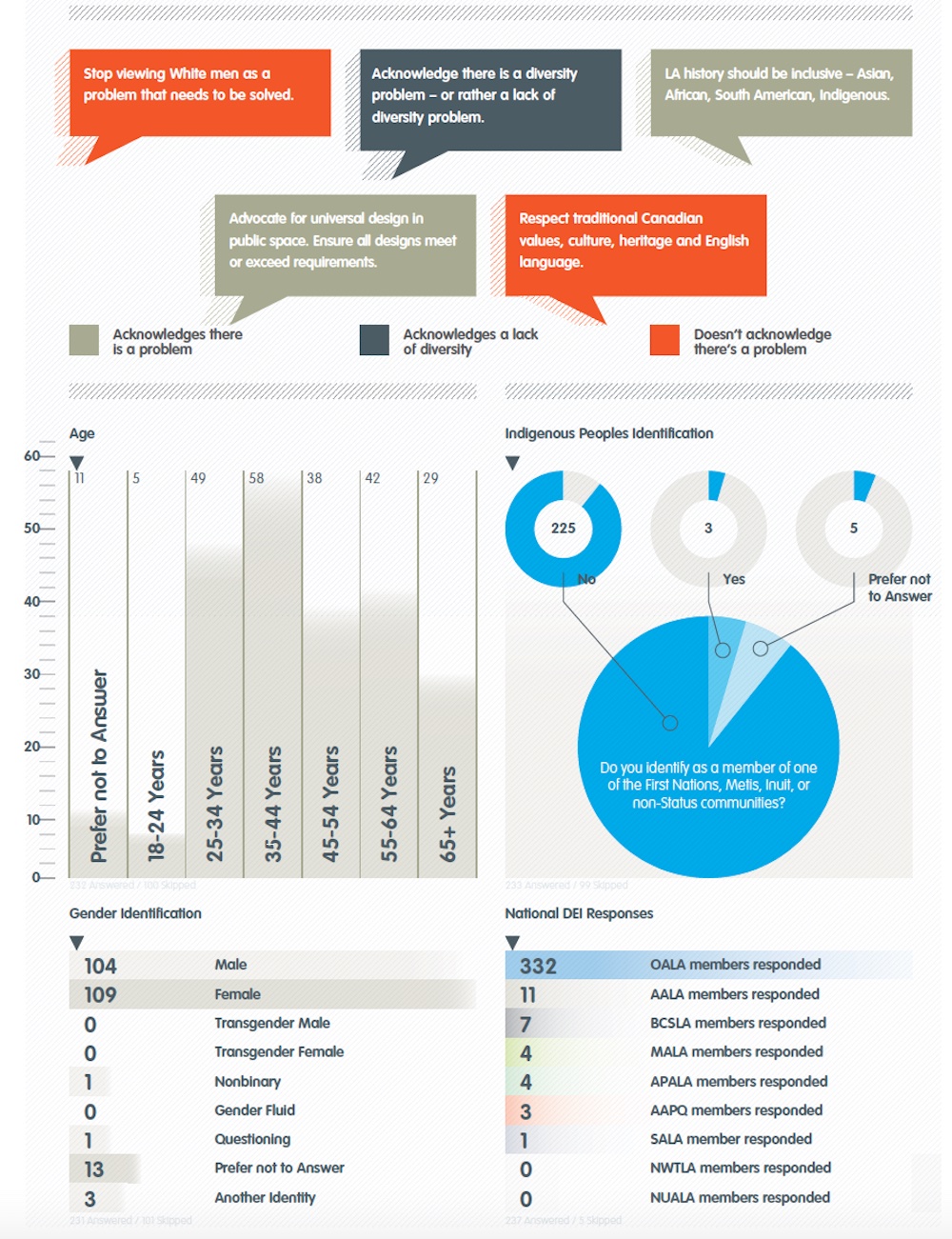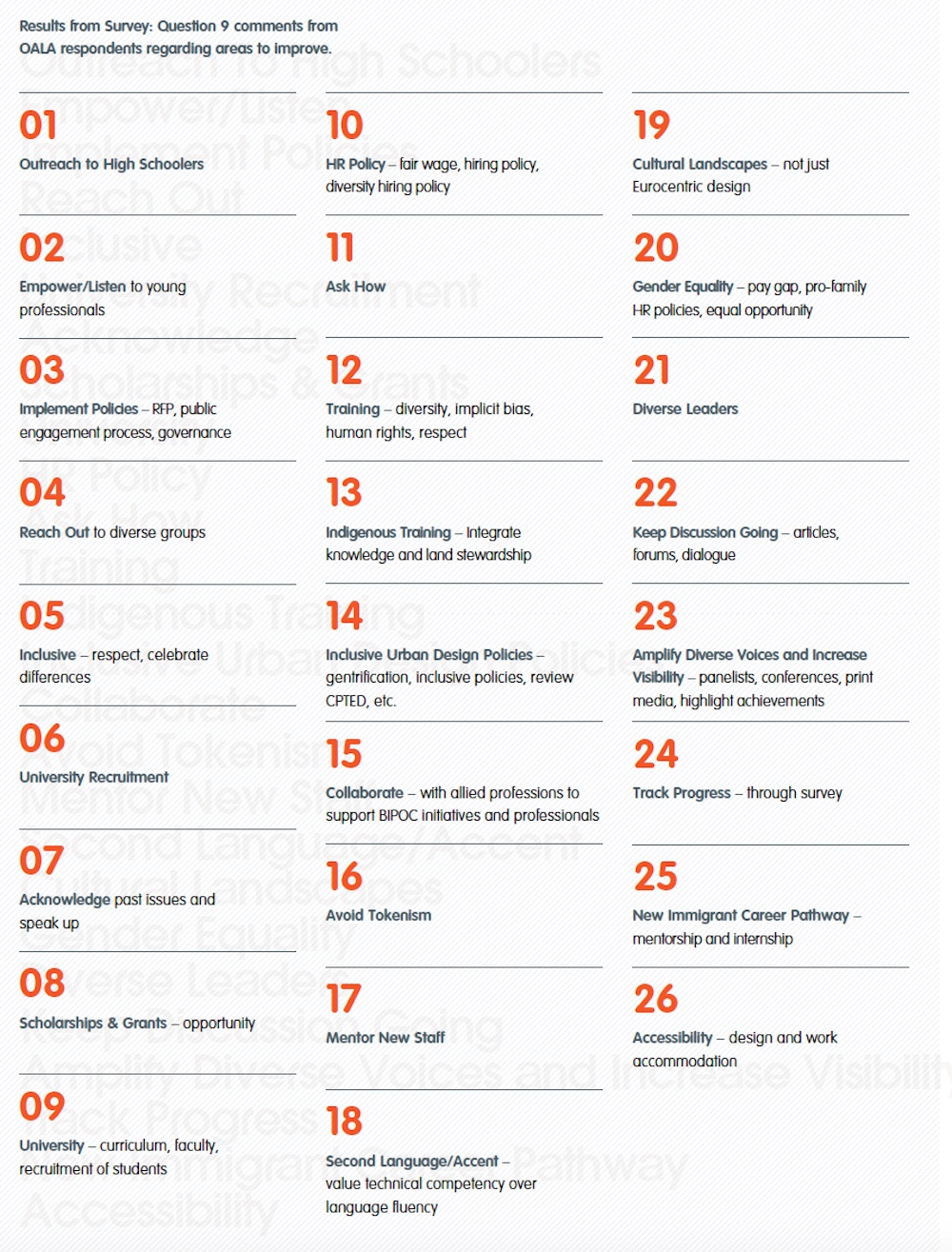Diversity in Canadian Landscape Architecture
Where we’ve come and where we need to go
Text by Kaari Kitawi, OALA and Helene Iardas, OALA
In Fall 2020, the CSLA, OALA, AALA, BCSLA, and MALA conducted a national Diversity, Equity, and Inclusion (DEI) survey as a joint initiative. The survey’s purpose was to inform and support the profession’s goal to build an inclusive environment, understand those impacted, and identify the improvements needed to achieve inclusivity.
The survey was partially in response to the June 8, 2020 Call to Action letter from OALA and CSLA members. One of the demands in the letter was for the OALA and CSLA to conduct “an annual formal diversity survey that includes a racial and gender breakdown for our membership so we can better understand our current membership base, how to engage a more racially-diverse member base, and to publish the results in an Annual Diversity and/or Annual Reconciliation Report.” To undertake the survey in a timely manner, the CSLA adapted an existing, research-validated diversity survey from a higher learning institution in Alberta.
The survey had 24 questions covering quantifiable data such as age, gender, race, ability, ethnicity, sexual orientation, religion, and language fluency. The survey also asked about members’ experience with discrimination, familiarity with diversity policies, and ideas on improving diversity in the profession.
Of the 2,009 OALA members, 332 (16.5 per cent) members responded to the survey. The survey outlined areas of inequity within this profession that are of concern to the responding members. In terms of race and ethnicity, recent demographics show there has been an increase in the number of East Asian professionals within the organization, but the number of Indigenous and Black landscape architects remains quite low. Gender issues rank as the greatest concern to responding members, followed by race and ethnicity. Survey respondents offered thoughtful and actionable suggestions for equity and reconciliation, reducing barriers, and promoting inclusivity.
Dr. Radu Craiu, the Professor and Chair of Statistical Sciences at the University of Toronto, told Ground one of the challenges of surveys is they are optional and, in many cases, are completed by individuals with strong views who therefore eager to participate. These are individuals on polar opposites of the spectrum on issues, being either deeply disgruntled or highly satisfied. “People who are sort of lukewarm or in the middle, or without any strong opinions, will not feel as compelled to participate.” To this end, surveys fall short of representing the opinions of people with middle-range views.

Shortcoming of the DEI Survey Questions
Certain survey questions were confusing and ultimately failed to provide useful information. Question 15, for example, received the lowest number of responses, and seemed to rile members. It asked: “Which racialized group(s) do you identify with?” It was preceded by Question 14 which asked, “We define a racialized individual as an individual who is identified or identifies as someone who is socially constructed as different among people and where this difference is based on characteristics such as accent or manner of speech, name, clothing, diet, beliefs and practices, leisure preferences, places of origin, and so forth. Do you identify as racialized?” One respondent responded, “The definition is so broad any person may be defined and identified as racialized.” In an attempt not to offend anyone by being all-encompassing, the question did the very opposite, and provided little useful information.
Question 15 was one of the most important in the survey: yet, it only had 85 responses. Of those responses, 31 were answered as “not applicable,” while the other 54 responses included a range of answers such as Asian, Disabled, Accent, Age and LGBTQ+, to name a few. Instead of focusing on all categories, this question’s focus should have been narrowed to a single category, in this case Race, and offer defined options to select from.
Other diversity surveys, such as The City of Toronto’s Count Yourself In, capture the gender, indigenous status, race, ability and sexual orientation composition of staff. The questions are clear, concise, and direct, with answer options provided. The Ontario Association of Architects also conducted a diversity survey in March 2021 (results were published June 2021). 1,323 Members out of 7,447 completed the survey. The question on race was “Which race category best describes you? Select all that apply,” and they provided answer options.
Lina Al-Dajani, chair of the CSLA’s Justice, Equity, Diversity and Inclusion Task Force, was not involved in the survey but acknowledged the survey has room for improvement. Perhaps, moving forward, the survey could make the questions clearer, focus on one category per question, and, where relevant, provide answer options.
How far we have come
The road to inclusion is a long one, and there’s a long way to go. The good news is the journey has already begun.
OALA women members have experienced glass ceilings, overt disrespect and derision at construction sites and in boardrooms, salary discrepancies, and double standards. They have since made inroads, attributable, in part, to their efforts and perseverance.
Today, gender is understood as a spectrum. Achieving equity across this spectrum will require sustained effort, but OALA membership has demonstrated some measure of success in dealing with gender—success that should inspire future progress.
The OALA includes members of diverse ages, genders, sexual orientations, abilities, cultures, races, and ethnicities—role models whose inspirational careers and stories, past and present, need to be heard. Let’s recognize and appreciate those landscape architects who helped, and are helping, to reduce barriers and promote equity within the organization and industry.
Next steps
Al-Dajani advised that CSLA and OALA Justice, Equity, Diversity and Inclusion task forces are preparing to hire a consultant to guide the development of a national and provincial action plan for the profession. “The consultant will also help to interpret the data collected and clarify what it means nationally, contributing to the action plan as a next steps,” she said. “There are also plans to improve upon this first survey and continue to issue effective and engaging diversity surveys, annually, so as to have measurable targets and performance indicators in support of an actionable plan that leads the profession to a demographic composition that is more accurately representative of its national and provincial populations.”
Who, What and Why
In Horton Hears a Who, Dr. Seuss tells the story of an elephant named Horton who hears a faint cry for help from a tiny speck of dirt. Upon investigation, Horton learns the entire population of the town of Whoville lives on that speck. To keep the town safe, Horton carefully places the speck on a clover, which he vigilantly protects.
The other animals in the jungle are perturbed by Horton’s obsession with protecting this “imaginary” town, and scheme to destroy the speck. In desperation, Horton calls on the Mayor of Whoville to get every Who to make a loud “Yopp!” sound in unison, so they can be heard by the other animals and, hopefully, prevent their demise. All efforts fail until, at last, they are joined by a final, tiny Who.
“That one small, extra Yopp put it over! Finally, at last! From that speck on that clover their voices were heard! They rang out clear and clean.” Whoville was saved.
To move the dial on diversity, equity and inclusion, every member will need to lend their voice and efforts. Some members may feel these issues are not part of “our work,” or we should focus on matters such as climate change. Our profession is focused on both environment and people. The inclusion of all people is part of our work. The environment, the land is at the core of landscape architecture. The very land on which we work as Canadians is the ancestral home of the Indigenous people. So, in essence, our practice infringes on the world-view and rights of others.
The challenges faced by Black, Indigenous, and People of Colour (BIPOC) are not unique to landscape architecture, but cut across other allied disciplines such as planning and architecture. I know of several BIPOC professionals with international and local training who struggled to secure an internship with a firm and start their professional accreditation process. Some opted to work in factories, while others changed careers altogether. How do you “earn your place” if you cannot get your foot through the door?
One survey respondent commented, “Organizations should not feel shame if their membership composition does not reflect the diversity of society.” But is it not our responsibility to ask why that is and what we can we do about it?
As the number of immigrants in our population and women in our practice continues to grow, it is prudent from an economic as well as social perspective to review our policies to accommodate all voices, in order to remain relevant. By not having diverse voices represented in our association, we are missing important perspectives. Let us embrace and tap into our multicultural identity as Canadians and remember diversity is indeed our strength.

BIO/ Helene Iardas, OALA (semi-retired), CSLA, RPP, MCIP (retired), graduated from the University of Guelph with a Bachelor of Landscape Architecture. Recently retired from Toronto City Planning.
Kaari Kitawi, OALA, is an Urban Designer at the City of Toronto and is a Ground Editorial Board Member. She has a masters degree of Landscape Architecture from the University of Toronto and a Bachelor of Science in Mathematics from Kenya. Prior to moving to Canada, Kaari ran her own landscape firm for over 10 years.
